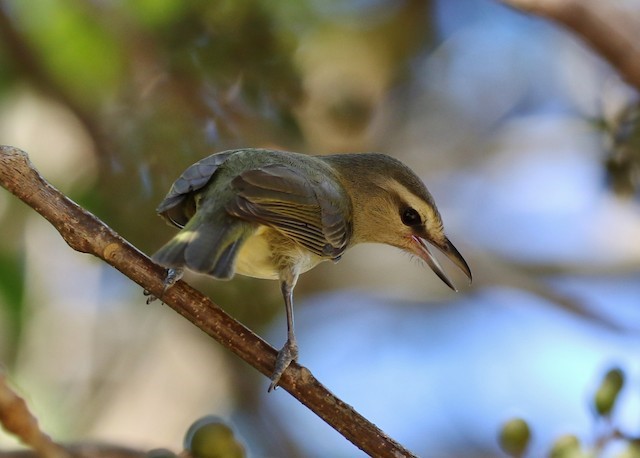Birdfinding.info ⇒ Very common throughout the “Mexican Riviera,” the Belizean cayes, and the Honduran Bay Islands, Roatán and Guanaja. On Grand Cayman, easily found at Botanic Park, the Mastic Trail, and North Side, but scarce within George Town.
Yucatán Vireo
Vireo magister
Resident on the Yucatán Peninsula, adjacent islands, and Grand Cayman, where it is common in mangroves and other coastal woodlands, and uncommon in interior woodlands and scrub.
On the mainland, most common along the coast from Cancun to southern Belize. Occurs at lower densities west across Quintana Roo and Yucatán State (to Celestún), and southeast to coastal Honduras (to Trujillo).
Inhabits all of the major nearshore islands from Holbox south and east to the Honduran Bay Islands. Also resident on Grand Cayman.
There is a single U.S. record: Crystal Beach, Texas, April 28 – May 27, 1984.
Identification
A large, mostly brownish vireo of the Red-eyed group—though its eye is dark brown. Has a long, heavy bill and broad, pale eyebrow accentuated by a dark, sometimes blackish, eyeline.
On most individuals, the eyebrow widens in front of the eye—on many the forehead is mostly pale, so the eyebrows join, like a visor. But in the Grand Cayman subspecies, caymanensis, the eyebrow typically narrows in front of the eye.
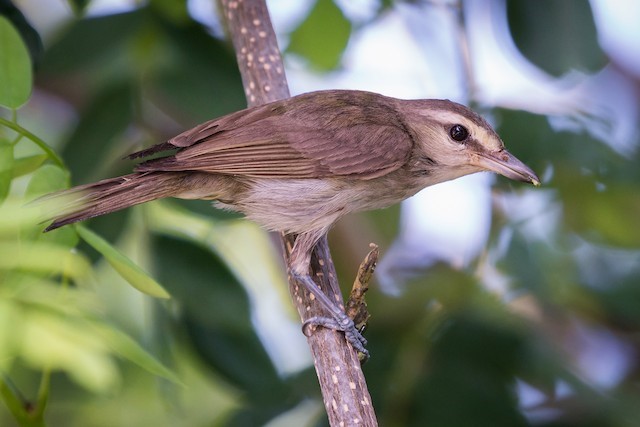
Yucatán Vireo, V. m. magister—note the massive bill. (Planetario Cha’an Ka’an de Cozumel, Quintana Roo, Mexico; July 2, 2017.) © Apolinar Basora
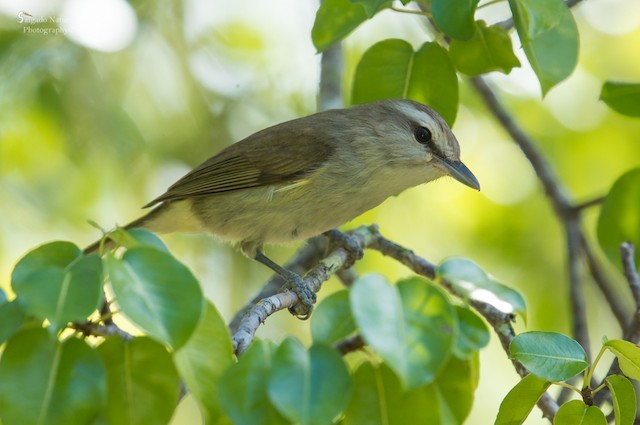
Yucatán Vireo, V. m. caymanensis. (Queen Elizabeth II Botanic Park, Grand Cayman; January 13, 2018.) © Julio Salgado
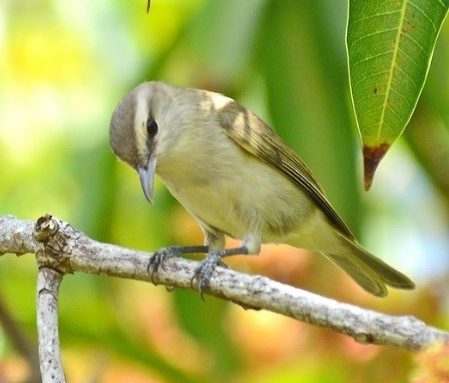
Yucatán Vireo, V. m. caymanensis, with tapering eyebrows and all-brown forehead, resembling Swainson’s Warbler. (Grand Cayman; March 19, 2013.) © Alan Van Norman
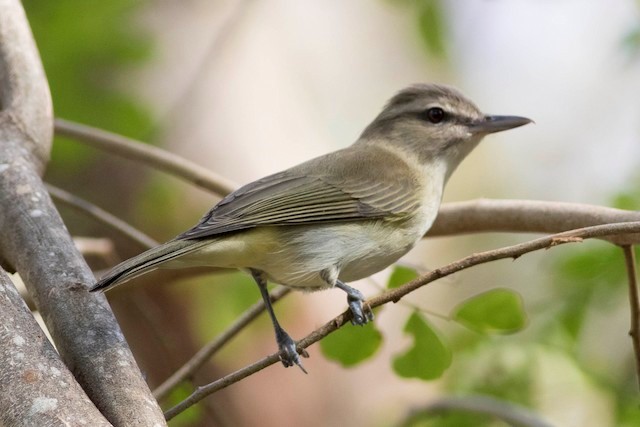
Yucatán Vireo, V. m. caymanensis, showing an apparent whisker mark, as on a Black-whiskered Vireo. This individual can be identified as a Yucatán Vireo by its brown crown (Black-whiskered has a grayish crown), dark eye, and the location. (West Bay, Grand Cayman; March 23, 2017) © Charmaine Anderson
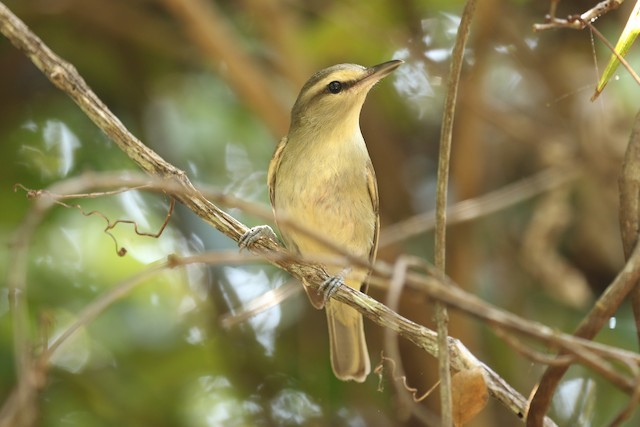
Yucatán Vireo, V. m. magister. (Puerto Morelos, Quintana Roo, Mexico; April 26, 2016.) © Bob Friedrichs
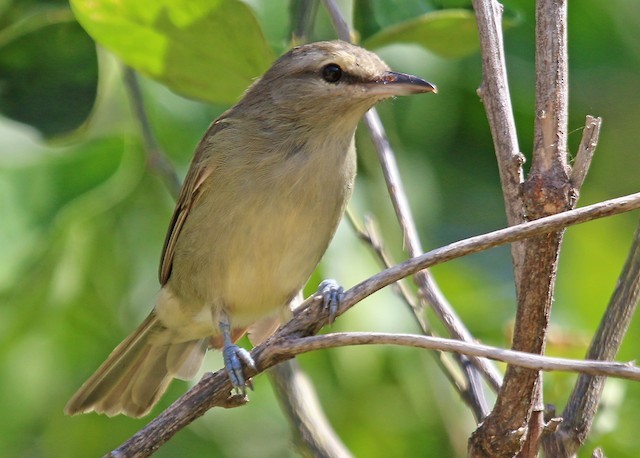
Yucatán Vireo, V. m. stilesi, showing apparently pale forehead. (Cayos Cochinos, Honduras; July 30, 2015.) © Corey Finger
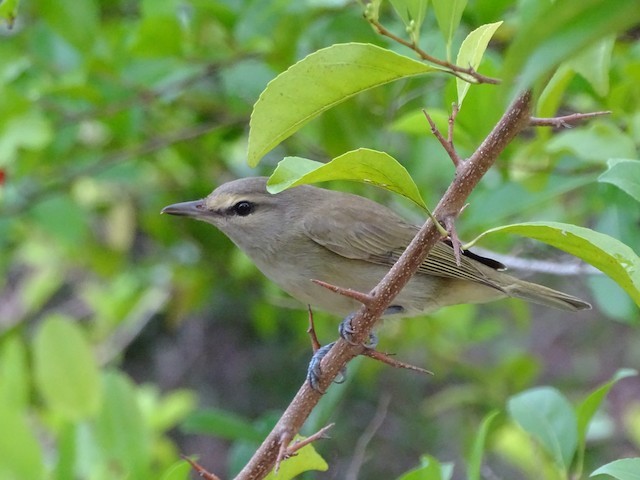
Yucatán Vireo, V. m. stilesi—this individual appears less brown, more olive and gray, than most. (Guanaja, Honduras; November 24, 2016.) © Alfonso Auerbach
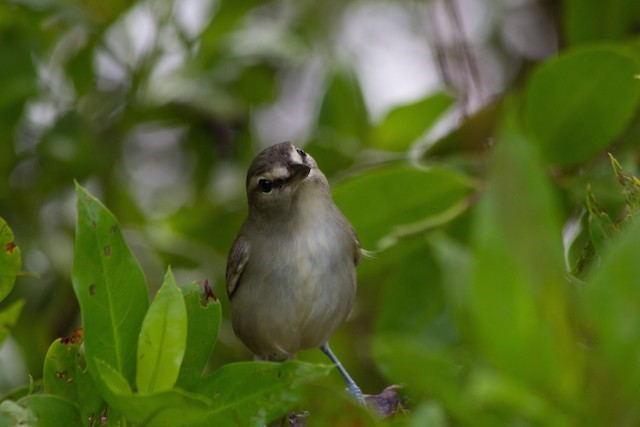
Yucatán Vireo, V. m. decoloratus—note that the eyebrows broaden in front of the eyes. (Caye Caulker, Belize; October 6, 2018.) © Francis Canto
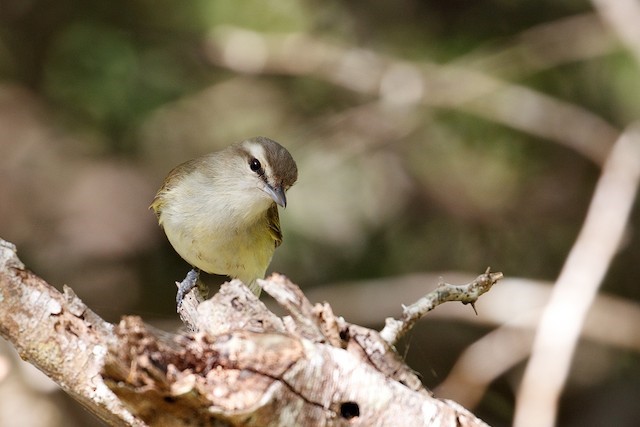
Yucatán Vireo, V. m. caymanensis, showing narrow, tapering eyebrows, not normally seen in other subspecies. (Queen Elizabeth II Botanic Park, Grand Cayman; January 5, 2018.) © Geoff Malosh
Cf. Black-whiskered Vireo. Yucatán Vireo sometimes shows a faint whisker streak, which may cause confusion with Black-whiskered Vireo. Black-whiskered usually has a pronounced whisker streak (but it can be faint or absent), and typically shows paler, reddish-brown irises and a grayish crown.
Cf. Swainson’s Warbler. Yucatán Vireos with narrow eyebrows and brown foreheads (especially those on Grand Cayman) can closely resemble Swainson’s Warbler, as they have approximately the same coloration and pattern. Both have proportionately long bills, though the warbler’s bill is thinner and sharper. Leg color differs unambiguously: Swainson’s Warbler has bright pink legs, whereas Yucatán Vireo has blackish legs.
Notes
Polytypic species consisting of four recognized subspecies: magister (majority of the range), decoloratus (some Belizean cays), stilesi (the Honduran Bay Islands), and caymanensis (Grand Cayman).
References
Brewer, D. 2018. Yucatan Vireo (Vireo magister). In Handbook of the Birds of the World Alive (J. del Hoyo, A. Elliott, J. Sargatal, D.A. Christie, and E. de Juana, eds.). Lynx Edicions, Barcelona. https://www.hbw.com/node/61270. (Accessed November 13, 2018.)
eBird. 2018. eBird: An online database of bird distribution and abundance. Cornell Lab of Ornithology, Ithaca, N.Y. http://www.ebird.org. (Accessed November 13, 2018.)
Fagan, J., and O. Komar. 2016. Peterson Field Guide to the Birds of Northern Central America. Houghton Mifflin Harcourt, New York.
Howell, S.N.G., and S. Webb. 1995. A Guide to the Birds of Mexico and Northern Central America. Oxford University Press, Oxford.
Raffaele, H., J. Wiley, O. Garrido, A. Keith, and J. Raffaele. 1998. A Guide to the Birds of the West Indies. Princeton University Press, Princeton, N.J.
